In 1984, the heyday of Transformers and Gobots, Tomy put forward a robot toy line like no other: the Starriors! Instead of rehashing the transformation gimmick, they used elegant mechanical designs and modular parts to make robots that were easy for play and affordable.
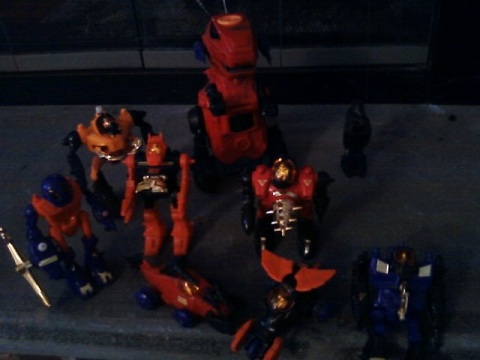
The most memorable thing about the Starriors is their post-apocalyptic backstory: “In the far flung future: Earth is devastated by deadly solar flares. Realizing his danger, Man creates the STARRIORS…” Man goes into “suspended animation” under an Armored Battlestation, leaving behind the Protectors to prepare the Earth for his return and the Destructors to fight off aliens. “Millennia pass. The STARRIORS develop their own civilization and much of their original programming is lost. Finally most remember man only as a legend.”
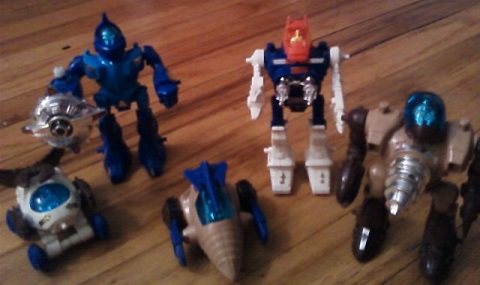
This is fairly sophisticated material for a kids’ toy line. The Protectors are facing the deep questions of who made them and why they were made, without being sure if their creator really exists or if it’s a good idea to discover him. A nice touch is that their “brain molds” are in Man’s image. So they go off into the “Forbidden Zone” (a la Planet of the Apes) searching for the Armored Battlestation in order to reawaken man. Meanwhile, the Destructor leader, Slaughter Steelgrave, knows that man exists but considers him much too dangerous to be awakened, so he leads the Destructors in pursuit of the rebels, without telling his followers the Protectors’ real mission.
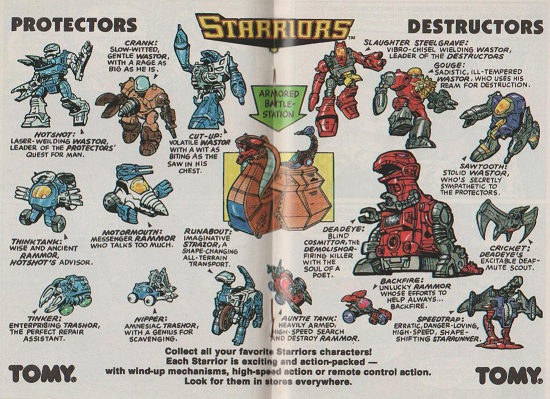
The original series of toys had several basic types. The main class was the humanoid Wastors, which all have windup mechanisms for some rotating or vibrating weapon, such as a chest-mounted blade. The variety of movement types and color schemes gives each character a unique feel, yet they all have interchangeable heads, arms, and legs, which can be repositioned as shown. There are a total of 12 Wastors, 6 of the original series (shown in the mini-comic insert) and 6 newer ones: Ripsaw, Flashfist, Twinblade (Protectors); Clawgut, Slice and Bolar (Destructors). Clawgut (pincers) and Slice (spinning axes) are shown with my Destructors, while Ripsaw (spinning blade shield) is among my Protectors.
The Rammors feature pull-back-and-race spring-loaded rear wheels, popular in 80s toy cars. This made them more playable, faster vehicles than Transformers or Gobots. All 4 Rammors (shown in my collection above) have interchangeable weaponry, wing-shaped spoilers, claws and hands.
Other Starrior types include the Trashors, with spring-loaded claws, and two vehicle-animal transforming robots, which zip faster than Rammors with the pull of a rip cord. The Strazor (named Runabout) converts from a dinosaur (sauropod) to a motorcycle, while the Starrunner (Speedtrap) converts from an ostrich-like ornithosaur to a jet hovercraft.
Two rare vehicles (which can be mounted by Wastors) are the Triceratops-like Stalker (named Twinhorn), and the Pteranodon-shaped Vultor (named Windstorm). These belong to the later series of the Starriors line.
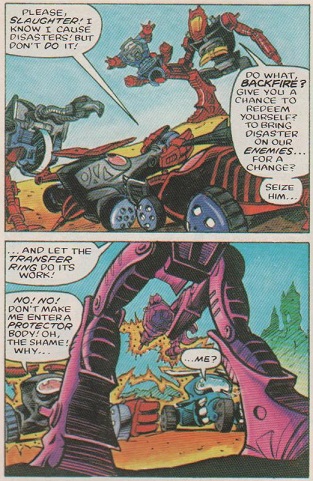 Lastly are the Transfer Rings, which can be worn on a kid’s finger or (more awkwardly) on a Wastor’s arm. According to the mini-comics, these are supposed to allow mind transfer from one Starrior to another of the same body type.
Lastly are the Transfer Rings, which can be worn on a kid’s finger or (more awkwardly) on a Wastor’s arm. According to the mini-comics, these are supposed to allow mind transfer from one Starrior to another of the same body type.
These lightweight plastic toys have held up surprisingly well 30 years later. In my collection, about half of the Wastor wind-up mechanisms still work. The Rammors’ pull-back racing mechanism still works, but some have cracked rubber tires. Ironically, the “unlucky” Backfire works the best, zipping 20 feet!
The most impressive Starrior is the Cosmittor, consisting of Deadeye and Cricket. This is a great design, not only because of Deadeye’s tyrannosuaur appearance and ability to shoot inch-wide disks, but because of its elegant remote control (Cricket) that works by single-button clicking and needs no batteries. (Deadeye requires 2 C’s.) Repeated clicks of the button offers full mobility: the first click fires disks (“Demolishors”); the second click makes Deadeye rotate; the third click makes him go forward; and the fourth click stops him. So you can aim accurately by choosing direction, then distance, then firing. The demolishors come out fast and fly across the room, though they don’t have enough force to knock over a Wastor.
My Cosmittor hadn’t been used in about 25 years, so I opened up Cricket and made sure the components made good contact. Then I put 2 fresh C batteries in Deadeye and… nothing. Oh well, too much to hope for. Later that night, I came home and heard a strange but familiar sound. Deadeye, amazingly, after some time to absorb the battery charge, still lives!
Starriors' Deadeye lives! by retro-geek
The minicomics that came with Starriors did a nice job of giving characterizations of everyone, such as Deadeye’s sense of honor, Crank’s nurturing concern for the Earth, and Gouge’s ruthlessness. The stories provide creative ideas for play beyond simple fighting and destruction. The original four Tomy minicomics are shown below. Two more came with the later series (No. 5 “The Wall” and No. 6 “Bolar!”).
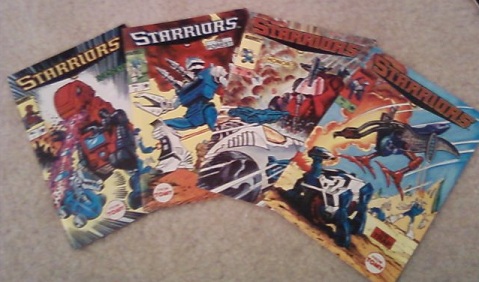
Marvel published a 4-issue mini-series which gave a complete story arc, with multiple character deaths culminating in the discovery of man! The Marvel stories blurred the lines of loyalty, making Auntie Tank and Sawtooth sympathize with the Protectors, while Motormouth sided with the Destructors. This story, while entertaining, was hardly conducive to toy play, since nothing was left to the imagination, a third of the characters die, and the open-ended quest is completed.
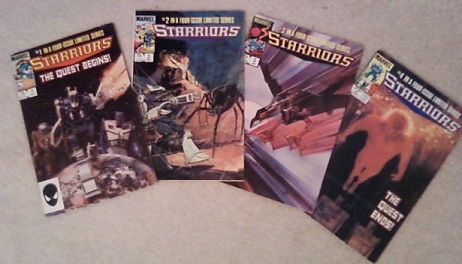
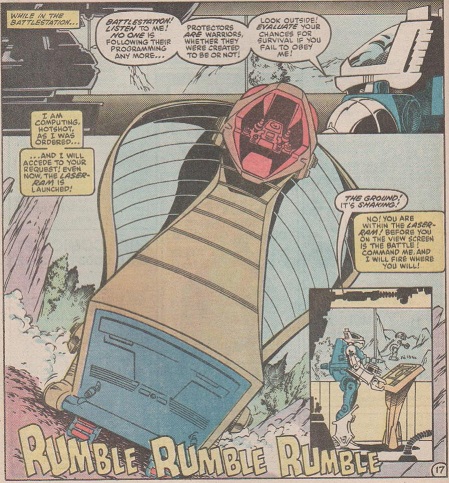 Still, the Marvel miniseries did a good job of showing how the Armored Battlestation would work to defend itself, even portraying the little scorpion robot as a character. The neatest feature of the Battlestation playset was the ability to launch the giant cobra ram, which shot forward on wheels with the press of a lever. My Battlestation is in storage, so it’s not pictured, but Mr. Hook’s Zoids Site has photos showing all its features: snake’s mouth opening to reveal laser cannons; door that opens in battle ram’s belly (so you could release a Rammor from within; various laser turrets and the scorpion guardian (called Stinger in the Marvel comic).
Still, the Marvel miniseries did a good job of showing how the Armored Battlestation would work to defend itself, even portraying the little scorpion robot as a character. The neatest feature of the Battlestation playset was the ability to launch the giant cobra ram, which shot forward on wheels with the press of a lever. My Battlestation is in storage, so it’s not pictured, but Mr. Hook’s Zoids Site has photos showing all its features: snake’s mouth opening to reveal laser cannons; door that opens in battle ram’s belly (so you could release a Rammor from within; various laser turrets and the scorpion guardian (called Stinger in the Marvel comic).
One weird thing in the final Marvel comic is that man turns out to be almost as tall as Starriors. It should be that man is about the same size as the “brain mold,” so that the Wastors are towering giants, and the Rammors are the size of tanks. Originally, the Starriors toys were intended to represent piloted vehicles, much like Tomy’s “Zoids” line of animal-shaped wind-up robots (including dinosaurs) from which they were spun off. They have decals that say “Danger,” “Beware of Blast,” and in some cases, “Rescue” arrows near the cockpit. The minicomics storyline made them much more interesting than if they had been mere piloted vehicles.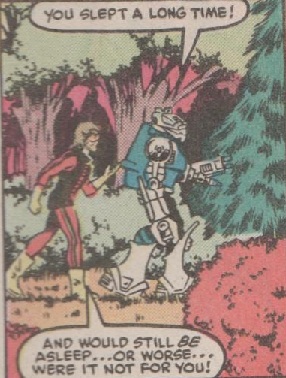
When collecting Starriors, beware of knockoffs and other releases mistaken for them. A common one is a much larger, batter-powered Strazor. Another is the UK line called RATS (Robot Anti Terror Squad) which uses the same molds as second-series Wastors, but with different color schemes or weapons. These are collectible in their own right, but should not be confused with the Starriors line. Another Starriors product to look for are the two Book and Record sets by Peter Pan Records.
It is not too difficult to get a complete set of Starriors, though the vehicles go for $70 each. Fortunately, they’re durable enough to entrust to a new generation of kids ages 8 and up.